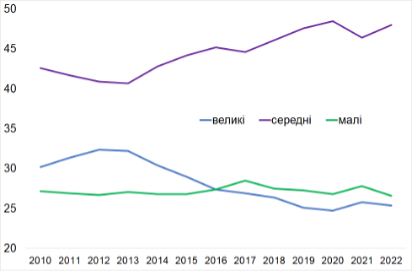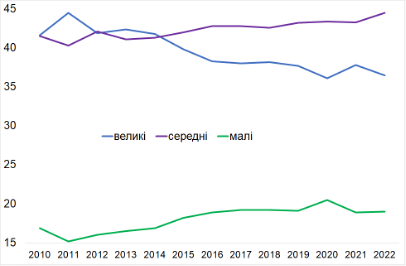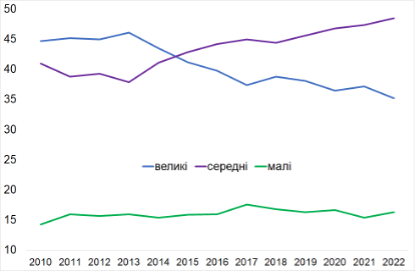One of the most important features of enterprises is their stability, that is, the ability to continue (effective and efficient) economic activity under negative external pressure. Of course, each enterprise "survives" in its own way, each one finds its own methods of coping with negative factors, each one finds and employs its own tools to counter external shocks.
Meanwhile, the general and instrumental capabilities of large, medium and small enterprises in maintaining their resilience have certain specific features. Quite many large enterprises are state-owned, and therefore have financial support from the state budget. Medium-sized enterprises have access to loans from "allied" banks. Small ones may count on (albeit rare) micro financing within the framework of separate incentive programs (such as "5-7-9"). In any case, economic stability is an important feature of the national business environment. How stable are Ukrainian enterprises in the first year of the large-scale Russian aggression?
First of all, let's note that the financial performance of Ukrainian enterprises, as reported by the State Statistics Service, testifies to significant losses in 2022. However, unexpectedly, the financial results of 2022 turned out to be relatively better than the relevant results during the first wave of aggression in 2014–2015 (table "Financial performance..."). That is, domestic business has acquired the experience of countering crisis shocks, which makes it possible to determine other comparative characteristics of enterprises.
Financial performance before taxes, UAH billion
|
2014 |
-564.4 |
|
2015 |
-348.5 |
|
… |
… |
|
2022 |
-216.6 |
(1). As a result of Russia's large-scale aggression, Ukraine in general lost about 30% of enterprises that were active at the beginning of 2022 (table "Number of active enterprises divided into large, medium, and small"). Meanwhile, losses for different groups of enterprises vary significantly. Say, the number of large enterprises decreased by almost 20%, small — by 30%, and the number of medium-sized enterprises decreased by a significantly smaller amount — about 15% (therefore, the share of medium-sized enterprises in the country increased by 1 percentage point and amounted to 5.6%).
Number of active enterprises divided into large, medium, and small
|
|
Total |
large |
% of total |
medium |
% of total |
small |
% of total |
|
2013 |
393327 |
659 |
0.2 |
18859 |
4.8 |
373809 |
95.0 |
|
2014 |
341001 |
497 |
0.1 |
15906 |
4.7 |
324598 |
95.2 |
|
2015 |
343440 |
423 |
0.1 |
15203 |
4.4 |
327814 |
95.5 |
|
2016 |
306369 |
383 |
0.1 |
14832 |
4.9 |
291154 |
95.0 |
|
… |
… |
|
|
|
|
|
|
|
2020 |
373822 |
512 |
0.1 |
17602 |
4.7 |
355708 |
95.2 |
|
2021 |
370834 |
610 |
0.2 |
17502 |
4.7 |
352722 |
95.1 |
|
2022 |
261924 |
494 |
0.2 |
14783 |
5.6 |
246647 |
94.2 |
According to the results of 2014 (the year of the first Russian invasion), the largest losses were experienced by large industrial enterprises. While the total (and medium, and small) reduction of operating enterprises amounted to 13–15% that year, the number of large ones decreased by a quarter.
(2). In terms of the number of employed, the biggest losses fall on small enterprises. If the overall decrease in the number of employed in 2022, compared to 2021, amounted to 16% (from 6.39 million workers to 5.38 million), and for large enterprises — about 17% (from 1.65 million to 1.37 million), for small ones, the decline amounted to almost 20% (from 1.78 million to 1.43 million). At the same time, the reduction for medium-sized enterprises turned out to be the smallest: 13% (2.97 million and 2.58 million, respectively). Therefore, the share of employees at medium-sized enterprises reached 48% of all employees at all types of enterprises (close to the record level of the coronavirus year 2020, when all enterprises also experienced an external shock) (diagram "Number of employees at enterprises divided into large, medium, and small").
Number of employees at enterprises divided into large, medium, and small enterprises, % of total

▬ large ▬ medium ▬ small
Let's also note that in recent years medium-sized enterprises have shown steady growth in terms of the number of employees; at large and small enterprises, annual changes in the numbers (increase/decrease) are insignificant. This produces a consistent increase in the share of employees of medium-sized enterprises.
(3). The fall in the volume of sales turned out to be commensurate with the decrease in the number of employees. In general, the volume of sales decreased by 19% (from UAH 13.6 trillion in 2021 to UAH 11.0 trillion in 2022), at large enterprises — by 22% (from UAH 5.1 trillion to 4.0 trillion UAH), at small ones — by 18.5% (from UAH 2.5 trillion to UAH 2.1 trillion), and least of all (again), at medium ones — by 17% (from UAH 5.9 trillion to 4.9 trillion UAH).
Therefore, the share of sales of medium-sized enterprises in the total volume of sales increased, having reached 45% (a record-high figure) (diagram "Sales of enterprises divided into large, medium, small").
(4). The general drop in production and sales, the decrease in the number of enterprises and employees, naturally also meant a (forced) decrease in the enterprises’ expenses on wages (some enterprises had to stop operation because they could not provide an adequate pay to employees). However, the aggregate labour costs in 2022 fell, compared to 2021, but by a significantly smaller amount. Total expenses decreased by 11% (from UAH 966 billion to UAH 861 billion), and payments at large enterprises decreased more significantly — by 15% (from UAH 359 billion to UAH 303 billion).
As for medium-sized and small enterprises, they to a large extent managed to maintain the volume of labour costs. In particular, the relevant expenses of medium-sized enterprises decreased by 9% (from UAH 458 billion to UAH 417 billion), of small enterprises — by only 6% (from UAH 149 billion to UAH 140 billion). Moreover, taking into account the significant drop in the number of employees, there are reasons to claim that such enterprises even raised wages to some categories of employees (including in order to keep skilled personnel).
That is, the total labour costs of medium-sized enterprises also reached a record level — almost 50% of the total labour costs (diagram "Labour costs of enterprises divided into large, medium, small").
Sales of enterprises divided into large, medium, small, % of total

▬ large ▬ medium ▬ small
Labour costs of enterprises divided into large, medium, small, % of total

▬ large ▬ medium ▬ small
So, despite the huge losses of the human and production capital, domestic enterprises proved capable of preserving the development and growth potential, and medium-sized enterprises turned out to be the most adapted to the shocks and challenges of war, thanks to the large-scale countermeasures against the ruination of the business environment, and hence, minimization of the consequences of aggression.
In such conditions, support for medium-sized businesses can be decisive for the acceleration of the country's recovery. Of course, this is not about additional benefits. The most important thing is to preserve the stability and predictability of the rules of the game, to continue the initiatives that have proven themselves well during the first year of the war — restriction of inspections, relaxation of fines, provision of interest-free loans and grants, etc. Clarity of the governmental policy, rationality of the rules of the game, access of medium-sized businesses to capital resources (in particular, through open participation in large-scale privatization) and information sources and channels (which, in particular, facilitate access to export markets), support for effective relocation practices, including for the return of enterprises to the liberated territories, will provide domestic medium-sized enterprises with sufficient incentives for efficient development.
https://razumkov.org.ua/komentari/yaki-pidpryiemstva-stiikishi




